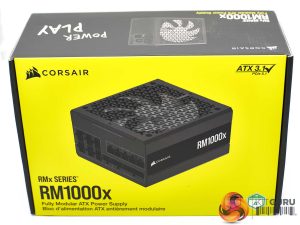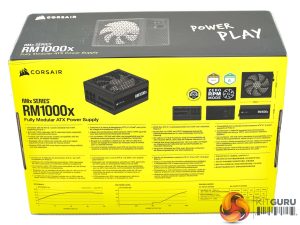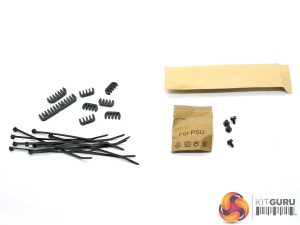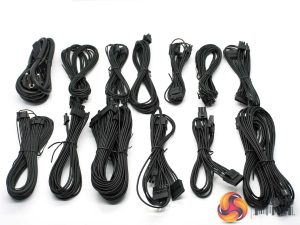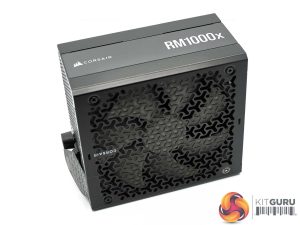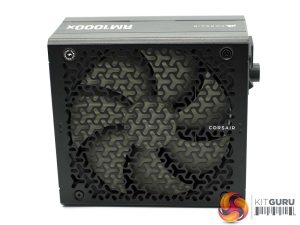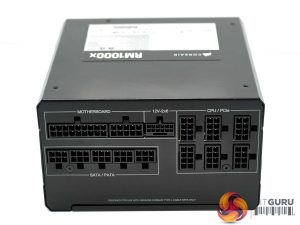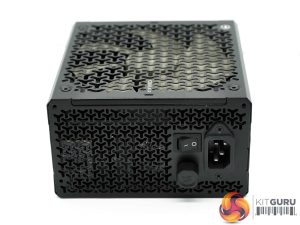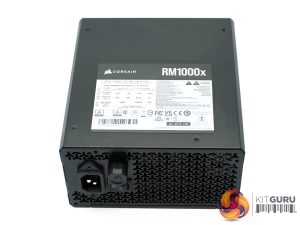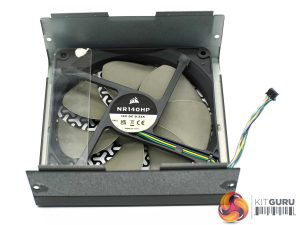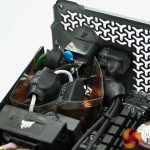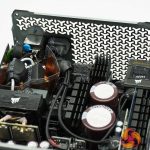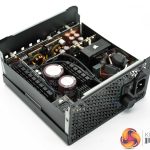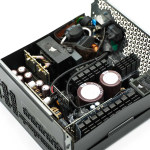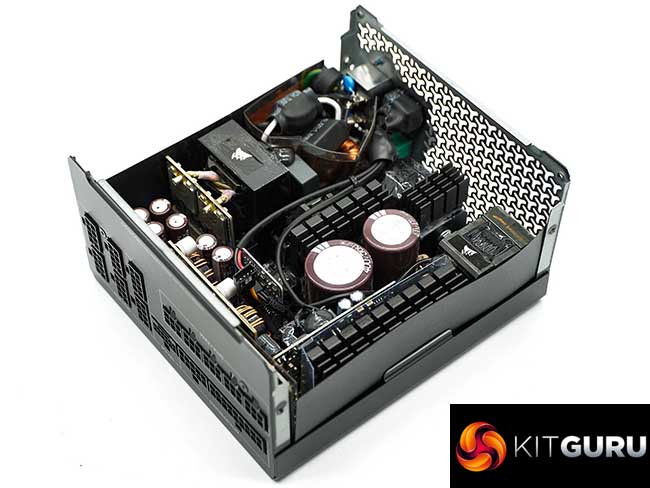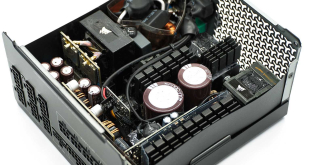
Following on from our review of the Corsair RM850x , today we look at the higher power model – the 1000 Watt RM1000x. The RMx range of power supplies has recently received an update from Corsair to meet the latest ATX 3.1 standards. These units also boast new fan controls which allow the end user to tweak fan speeds under lighter loads. This unit is fully modular and incorporates all Japanese capacitors alongside low-noise dynamic bearing fans. Corsair backs the range with a full 10 year warranty.
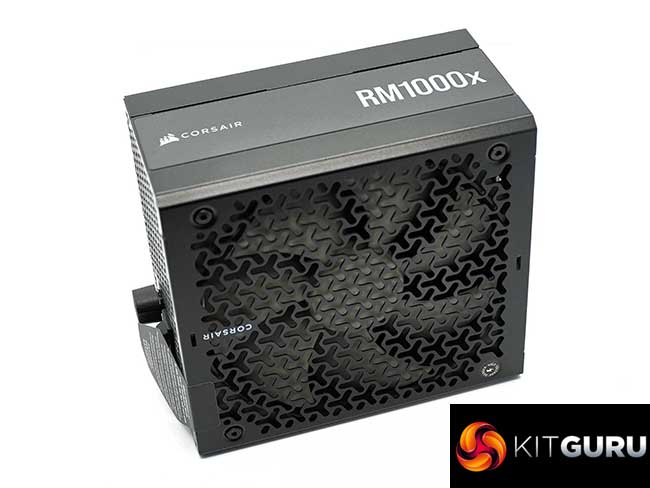
Key features:
- Fully Modular PSU: Reliable and efficient low-noise power supply with fully modular cabling, so you only have to connect the cables your system build needs.
- Intel® ATX 3.1 Certified: Compliant with the ATX 3.1 power standard, supporting the PCIe Gen 5 platform and resisting transient power spikes.
- Native 12V-2×6 Connector: Ensures compatibility with the latest graphics cards with a direct GPU to PSU connection – no adapter necessary.
- 100% Japanese Capacitors: Delivers steady, reliable power and dependable electrical performance with 105°C-rated Japanese capacitors.
- Low Noise with 140mm Fan: A 140mm FDB fan with a specially calculated fan curve ensures low-noise operation even at full load, with a fan speed adjustment knob on the back for quick manual control.
- Six-Layer PCB: A modular PCB with 50% more layers provides improved voltage stability and heat dissipation.
- 50oC Maximum Operating Temperature: For reliable power even under high-stress conditions.
- Modern Standby Compatible: Extremely fast wake-from-sleep times and better low-load efficiency.
- Cybenetics Gold-Certified: Steady power output at up to 90% efficiency, less noise, and cooler temperatures.
- Zero RPM Fan Mode: For near-silent operation at lower loads.
- Resonant LLC Topology with DC-to-DC Conversion: Provides clean, consistent power and enables use of more energy-efficient sleep states.
- Ten-Year Warranty: Your guarantee of reliable operation for peace of mind through multiple builds.
Above we can see the distinctive look of Corsair power supply boxes – they've been the same for as long as I can remember. The bright yellow colours are sure to attract attention in a retail environment (there are still physical stores, right?).
The rear of the box lists some key selling points, highlighting the zero fan mode, 10 year warranty and the physical dimensions of the unit itself.
Inside the box, Corsair include some cable ties, cable combs, as well as mounting screws in separate containers.
The cable quality is very good and better than many of the previous Corsair units I have reviewed. They include two EPS and four PCIe 6+2 pin connectors as well as one 12+4 pin connector, all on separate cables which is good to see. There are no in-cable capacitors on any of the cables.
The Corsair RM1000x measures 150 mm x 85 mm x 160 mm (WxHxD) and it weighs around 1.8KG. These physical dimensions will suit any ATX chassis on the market today.
The fan is protected behind a grille, which offers plenty of airflow capabilities. The 140mm unit is marked as a high grade FDB (fluid dynamic bearing) fan. We will have a closer look at the fan when we open the power supply shortly.
The modular bay is split into three sections – seen in the image above. These are clearly labelled for ease of installation.
The other side of the power supply houses the power cable and switch along with the fan control knob. This allows the end user to tweak fan speeds under lighter and moderate loads and you can even disable it completely at low loads to reduce noise levels.
The RM1000x delivers 20A to both +3.3V and +5V rails. The primary +12V rail can handle up to 83.3A – this is an increase from the 70.8A of the RM850x.
Corsair are using the NR140HP fan inside this power supply. It is a 140mm unit and rated 12V DC 0.33A. This is a high grade fluid dynamic bearing fan that is quiet at lower speeds. This is the same fan that is in the RM850x. A small plastic strip is angled on the underside of the fan to help concentrate airflow across some of the components inside.
This power supply is produced for Corsair by Channel Well Technology (CWT). Corsair have been working with CWT now for some time and they have produced some very good power supplies over the years. This unit is a modern design implementation – half bridge topology with an APFC converter and an LLC resonant converter on the primary side. The secondary side adopted a synchronous rectification system for the 12V rail and a pair of DC-DC converters for the minor rails. Corsair and CWT adopt several daughter cards to help with horizontal spacing inside the chassis.
Soldering and build quality is high throughout the unit, just like the RM850x I reviewed recently. The two primary capacitors are Nippon Chemi Con from their KMW series. The two caps are rated 400v 470uF and 400v 560uF for a total of 1030uF. The RM850x has two 470uF capacitors, so the bigger single 560uF capacitor has been the upgrade for the 1000 Watt unit.
Correctly testing power supplies is a complex procedure and KitGuru have configured a test bench which can deliver up to a 2,000 Watt DC load.
We test ambient temperatures at 35c in our environment to greater reflect warmer internal chassis conditions.
We use combinations of the following hardware:
• SunMoon SM-268
• CSI3710A Programmable DC load (+3.3V and +5V outputs)
• CSI3711A Programmable DC load (+12V1, +12V2, +12V3, and +12V4)
• Extech Power Analyzer
• Extech MultiMaster MM570 digital multimeter
• SkyTronic DSL 2 Digital Sound Level Meter (6-130dBa)
• Digital oscilloscope (20M S/s with 12 Bit ADC)
• Variable Autotransformer, 1.4 KVA
We test in a single +12V configuration.
|
DC Output Load Regulation
|
||||||||||
|
Combined DC Load |
+3.3V
|
+5V
|
+12V
|
+5VSB
|
-12V | |||||
|
A
|
V
|
A
|
V
|
A
|
V
|
A
|
V
|
A | V | |
|
100W
|
0.90
|
3.33
|
0.90
|
5.00
|
7.35
|
12.02
|
0.50
|
5.00
|
0.20
|
-12.01
|
|
200W
|
1.60
|
3.33
|
1.64
|
5.00
|
15.13
|
12.02
|
1.00
|
5.01
|
0.20
|
-12.00
|
|
500W
|
3.21
|
3.33
|
3.24
|
5.00
|
38.60
|
12.01
|
1.50
|
5.01
|
0.20
|
-12.01
|
| 750W |
4.03
|
3.33
|
4.17
|
5.00
|
58.53
|
12.01
|
2.00
|
5.00
|
0.30
|
-12.00
|
|
1000W
|
5.45
|
3.33
|
5.51
|
5.00
|
78.13
|
11.99
|
2.50
|
5.00
|
0.30
|
-12.01
|
The load regulation of this power supply is excellent across the board.
Next we want to try Cross Loading. This basically means loads which are not balanced. If a PC for instance needs 500W on the +12V outputs but something like 30W via the combined 3.3V and +5V outputs then the voltage regulation can fluctuate badly.
The power supply had no problems sustaining at constant 1000W load.
| Cross Load Testing | +3.3V | +5V | +12V | -12V | +5VSB | |||||
| A | V | A | V | A | V | A | V | A | V | |
| 885W | 2.0 | 3.33 | 2.0 | 5.01 | 72.0 | 11.99 | 0.2 | -12.01 | 0.50 | 5.00 |
| 240W | 20.0 | 3.33 | 23.0 | 4.98 | 2.0 | 12.01 | 0.2 | -12.01 | 0.50 | 5.01 |
The RM1000x handled our cross load test very well, holding stable results across the range.
We then used an oscilloscope to measure AC ripple and noise present on the DC outputs. We set the oscilloscope time base to check for AC ripple at both high and low ends of the spectrum. ATX12V V2.2 specification for DC output ripple and noise is defined in the ATX 12V power supply design guide.
|
ATX12V Ver 2.2 Noise/Ripple Tolerance
|
|
|
Output
|
Ripple (mV p-p)
|
|
+3.3V
|
50
|
|
+5V
|
50
|
|
+12V1
|
120
|
|
+12V2
|
120
|
|
-12V
|
120
|
|
+5VSB
|
50
|
Obviously when measuring AC noise and ripple on the DC outputs, the cleaner (less recorded) means we have a better end result. We measured this AC signal amplitude to see how closely the unit complied with the ATX standard.
| AC Ripple (mV p-p) | ||||
| DC Load | +3.3V | +5V | +12V | 5VSB |
| 100W | 9 | 8 | 8 | 9 |
| 250W | 11 | 12 | 11 | 11 |
| 500W | 14 | 15 | 14 | 13 |
| 750W | 17 | 16 | 18 | 14 |
| 1000W | 19 | 18 | 23 | 15 |
Ripple noise suppression is excellent, with the primary +12V rail peaking at 23mV at full load. Secondary +3.3V and +5V rails both peak around 20mV at full load.
|
Efficiency (%)
|
|
|
100W
|
89.3
|
|
250W
|
91.2
|
|
500W
|
92.1
|
|
750W
|
91.7
|
|
1000W
|
89.6
|
The efficiency results are excellent, peaking at 92% at around 50% load. This drops to around 90% efficiency at full load.
We take the issue of noise very seriously at KitGuru and this is why we have built a special home brew system as a reference point when we test noise levels of various components. Why do this? Well this means we can eliminate secondary noise pollution in the test room and concentrate on components we are testing. It also brings us slightly closer to industry standards, such as DIN 45635.
Today to test the Power Supply we have taken it into our acoustics room environment and have set our SkyTronic DSL 2 Digital Sound Level Meter (6-130dBa) one meter away from the unit. We have no other fans running so we can effectively measure just the noise from the unit itself.
As this can be a little confusing for people, here are various dBa ratings in with real world situations to help describe the various levels.
KitGuru noise guide
10dBA
– Normal Breathing/Rustling Leaves
20-25dBA
– Whisper
30dBA
– High Quality Computer fan
40dBA
– A Bubbling Brook, or a Refrigerator
50dBA
– Normal Conversation
60dBA
– Laughter
70dBA
– Vacuum Cleaner or Hairdryer
80dBA
– City Traffic or a Garbage Disposal
90dBA
– Motorcycle or Lawnmower
100dBA
– MP3 Player at maximum output
110dBA
– Orchestra
120dBA
– Front row rock concert/Jet Engine
130dBA
– Threshold of Pain
140dBA
– Military Jet takeoff/Gunshot (close range)
160dBA
– Instant Perforation of eardrum
|
Noise (dBA)
|
|
|
100W
|
<28.0
|
|
250W
|
<28.0
|
|
500W
|
31.8
|
|
750W
|
34.6
|
| 1000W | 37.9 |
The fan remains relatively quiet throughout the range, picking up some speed at around 700 Watt load, when it becomes more audible. At full load the fan is clearly audible, but it would not be too intrusive if it were inside a case.
|
Temperature (c)
|
||
|
Intake
|
Exhaust
|
|
|
100W
|
37
|
41
|
|
250W
|
38
|
44
|
|
500W
|
40
|
51
|
|
750W
|
45
|
56
|
|
1000W
|
46
|
60
|
Temperatures inside the chassis remain at really good levels throughout the load range.
This is our second look at the new Corsair RMx platform and the 1000 Watt RM1000x does not disappoint either. The build quality is very high and the adoption of a high-grade FDB (fluid dynamic bearing) fan is always good to see. We think the addition of a control knob to tweak fan speeds is interesting and it could help to reduce noise levels at lower loads, if that is your preference. Like the 850 Watt unit , this power supply is reasonably quiet at high loads and the cooling capabilities of the fan work well.
As mentioned previously, this partnership with Channel Well Technology (CWT) has proven positive for Corsair. The fact they have the extremely talented Jonny Guru working for them now means their designs get better every year. The power supply is well thought-out and put together with 105C-rated capacitors from Japanese brand Nippon Chemi Con used in the primary stage (one is upgraded from 470uF in the RM850x to 560uF here). Soldering quality is just as good as the 850W model and several large heatsinks are placed throughout to deal with heat dissipation.
Technically the RM1000x is rock solid. Ripple suppression is tight, as is load regulation across primary and secondary rails. Efficiency rates well for a Gold rated supply and as I said before, I like how Corsair are ditching the dated 80 Plus system for a focus on the more capable (and reliable) Cybenetics platform. Another positive with the new RMx series is the inclusion of high quality modular cables, some of the best we have seen this year.
The pricing of this power supply is £179.99 in the UK direct from the Corsair website HERE . This is not a budget unit but I feel it is worth the money.
It is worth pointing out that there are previous versions of the RM1000x power supply still being sold online, so make sure you get this latest version. Corsair are standing behind the RM1000x with a 10 year warranty, for peace of mind.
Discuss on our Facebook page HERE .
Pros:
- ATX 3.1 and PCIe 5.1 ready.
- Cybenetics Gold Efficiency certification.
- Tight load regulation.
- Great ripple suppression.
- Low noise until higher loads.
- Fluid dynamic bearing fan.
- 10 year warranty.
- Fully modular.
- Control knob to adjust fan speed.
- Delivers the full 1000 Watts.
Cons:
- It's quite expensive.
KitGuru says: The Corsair RM1000x is just as good as the RM850x power supply. The build quality and modular cabling are both excellent. Technically, ripple suppression is tight and we value the use of low noise, long life fluid dynamic bearing fans inside these units. The new manually controlled fan offers versatile noise control at lower loads, which will be welcomed by a large audience of enthusiast users trying to reduce system noise. The RM1000x comes highly recommended.
 KitGuru KitGuru.net – Tech News | Hardware News | Hardware Reviews | IOS | Mobile | Gaming | Graphics Cards
KitGuru KitGuru.net – Tech News | Hardware News | Hardware Reviews | IOS | Mobile | Gaming | Graphics Cards


